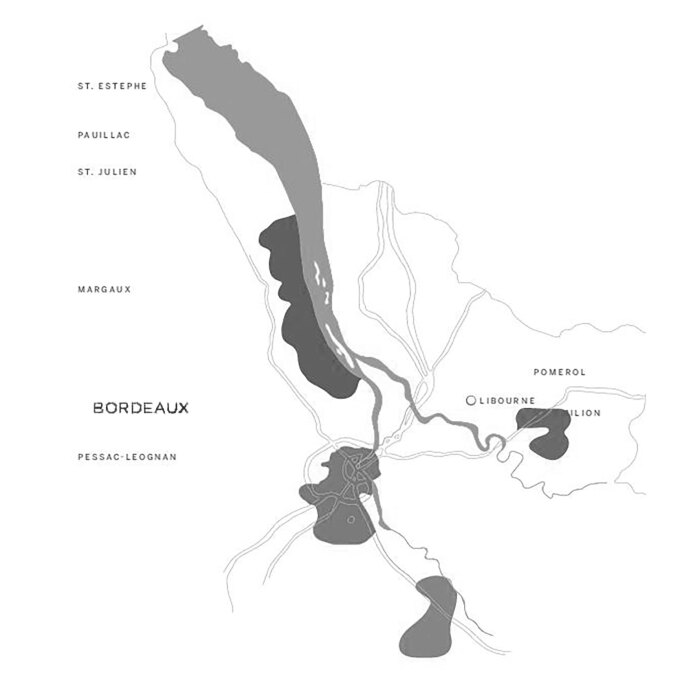B ordeaux is a singular region in France, yet there is a great diversity among the wines produced there. This is a result of many factors including varietals grown, topography and soil, microclimate and the stylistic decisions made by the Châteaux themselves.
Here’s a quick guide of the Bordeaux wine collection, explaining some of the broad sweeping differences of Bordeaux collector wines in each major appellation. Click here to view all Bordeaux wines available for immediate purchase.

Left Bank
Saint-Estèphe
Saint-Estèphe in the Left Bank of Bordeaux, France is the northernmost wine commune. The winemakers of this region produce red wines dominated by Cabernet Sauvignon and Merlot, often displaying earthy and savory aromas even in their youth. Saint-Estèphe wines are known for their distinct tannic profile, a result of a slightly cooler microclimate and a unique gravel and clay mixture in the soil.
Top Châteaux include: Montrose, Cos d’Estournel and Calon-Ségur.
Click here to view all Saint-Estèphe wines available for immediate purchase.
Wines at Auction
Pauillac
The Pauillac wine commune is perhaps the most famous among all Bordeaux wine appellations due to its three first growths: Châteaux Lafite Rothschild, Latour and Mouton Rothschild.
The Pauillac terroir is unique for the natural drainage provided by its gravel. Young wines from this appellation tend to have a good tannic structure while displaying intensity, power and a concentration of their fruit qualities.
Top Châteaux include: Lafite Rothschild, Latour, Mouton Rothschild, Pichon Lalande, Pichon Baron and Lynch Bages.
Click here to view all Pauillac wines available for immediate purchase.
Wines at Auction
Saint-Julien
Saint-Julien has a fairly uniform gravel surface including a complex clay and limestone soil layer that makes this Bordeaux commune’s wine production quite diverse. Saint-Julien wines fall between the powerful Pauillac and the elegant Margaux, and are known for their intense yet subtle notes of fruit and tobacco.
Top Châteaux include: Léoville Las Cases, Léoville Barton, Beychevelle and Ducru Beaucaillou.
Click here to view all Saint-Julien wines available for immediate purchase.
Wines at Auction
Margaux
Margaux is situated in a key area benefiting from the wine region’s mild winters and summers. The unique landscape of gravely hilltops along with the gravel- and pebble-rich soil encourage deep root growth and, therefore, high-quality grapes. The red wine from this region is known for its elegance and tends to have a floral perfume and a silky texture.
Top Châteaux include: Margaux, Palmer and Rauzan-Ségla.
Click here to view all Margaux wines available for immediate purchase.
Wines at Auction
Pessac-Léognan
The Pessac-Léognan subregion is located just south of the city of Bordeaux and is home to another First Growth: Château Haut Brion. The terroir is covered in hills with a mineral-rich soil that provides a mineral quality to its famous red and white wines. The well-drained, gravelly soils are particularly favorable to Cabernet Sauvignon.
Top Châteaux include: Haut Brion and La Mission Haut Brion.
Click here to view all Pessac-Léognan wines available for immediate purchase.
Graves
Graves is an appellation located in the upstream section of the Left Bank, southeast of the city of Bordeaux. Graves takes its name from the uniquely deep, gravel-rich soil of the region, which lends itself to a diverse collection. While red wine based on Cabernet Sauvignon and Merlot dominates the subregion, Graves is also famed for its dry white wines combining Sauvignon Blanc and Sémillon, as well as specialized sweet wines, particularly from the commune of Sauternes.
Top Châteaux include: Climons, Doisy Daëne and Riussec.
Wines at Auction
Right Bank
Saint-Émilion
Saint-Émilion is situated on a limestone plateau in the Right Bank. The chalky-clay makeup of the soils is particularly favorable to Cabernet Franc and Merlot, producing fine wines that show more fruit character, velvety tannins, and finesse with a rounded body.
Top Châteaux include: Cheval Blanc, Angélus and Figeac.
Click here to view all Saint-Émilion wines available for immediate purchase.
Pomerol
Pomerol is the smallest Bordeaux wine appellation with some of the smallest estates in the region – but it is also home to its most sought after and expensive wines. Merlot is the most famous grape here, grown extensively across the plateau. The iron-rich clay soils, known as crasse de fer, produce full-bodied red wines of extraordinary depth and showcase Merlot at its finest.
Top Châteaux include: Pétrus, Le Pin, Lafleur and Trotanoy.
Click here to view all Pomerol wines available for immediate purchase.
































